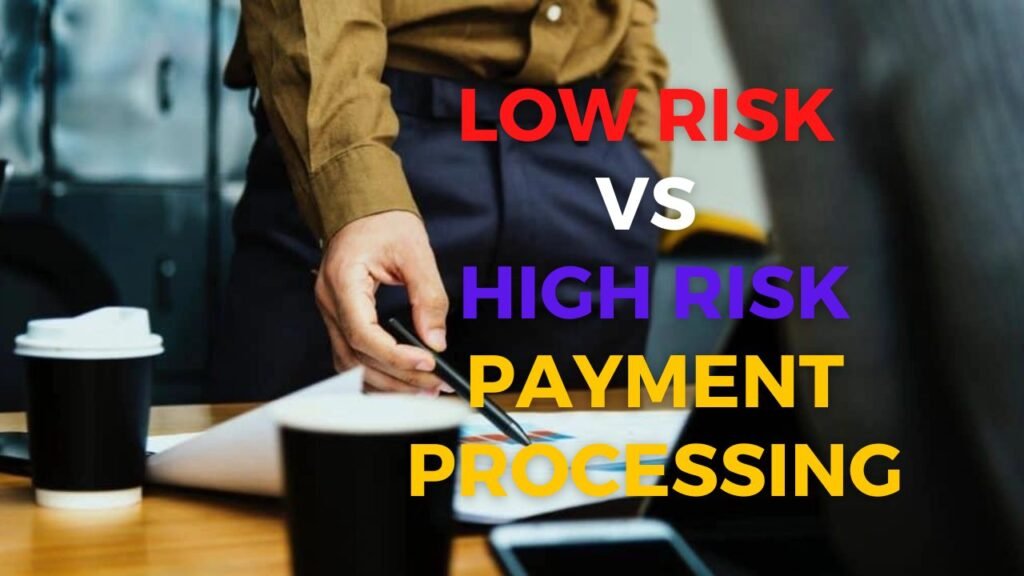Low Risk Vs High Risk Payment Processing

Low Risk Vs High Risk Payment Processing refers to the two categories of payment processing that businesses can choose from based on the level of risk associated with each transaction. In low-risk payment processing, the risk of fraudulent activity is relatively low. In contrast, high-risk payment processing involves a higher level of risk due to the potential for fraudulent activity. Businesses must understand the differences and choose the option that best suits their needs. This decision can impact their bottom line, making it crucial for businesses to consider the associated risks and benefits before choosing.
Payment processing is critical to conducting business in today’s digital world. As more transactions are conducted online, businesses must carefully evaluate their payment processing options to ensure smooth transactions, secure customer data, and maximize profits. One of the critical considerations in payment processing is the risk associated with different types of transactions. Businesses often face the challenge of categorizing transactions as low-risk or high-risk and determining the best payment processing approach for each category.
This article will explore the differences between the two, uncover the associated risks and rewards, and discover strategies to mitigate risks and optimize profits. We will also address common FAQs to understand this complex topic comprehensively.
Low Risk vs High Risk Payment Processing: Understanding the Differences

Let’s first define what each category entails.
Low-Risk Payment Processing refers to transactions considered less risky in terms of potential chargebacks or fraud. These transactions typically involve low transaction amounts, reputable customers, and a low likelihood of disputes or refunds. Low-risk industries include retail, grocery stores, and utility payments.
On the other hand, High-Risk Payment Processing involves:
- Transactions with high chargeback rates.
- The potential for fraud.
- Involvement in industries with higher rates of disputes or refunds.
High-risk industries include online gaming, adult entertainment, and e-commerce businesses with high-ticket items.
The distinction between these two payment processing is crucial as it determines the payment processing options available to businesses and the associated costs and risks.
Risks and Rewards of Low Risk vs High Risk Payment Processing

Both payment processing comes with its own set of risks and rewards. Understanding these are essential for businesses to make informed decisions and optimize their strategy.
Risks of Low-Risk Payment Processing
While these may seem less risky, there are still potential drawbacks that businesses need to be aware of, including.
- Chargebacks happen when a customer rejects a transaction and asks their bank or credit card issuer for a refund. Low-risk businesses may still face chargebacks due to issues such as product returns, customer disputes, or transaction errors.
- Fraud: Although these transactions are generally considered safer from fraud, businesses must implement adequate preventive measures to protect against fraudulent activities, such as stolen credit card information or identity theft.
- Limited Payment Processing Options: These businesses may have limited payment processing options, as some industries charge higher fees for low-risk transactions.
Rewards of Low-Risk Payment Processing
- Lower Transaction Fees: These typically attract lower transaction fees compared to high-risk transactions, as they are considered less risky for payment processors.
- Higher Approval Rates: These are more likely to be approved by payment processors, as they are perceived as less risky. It ensures smoother payment processing and minimizes the risk of declined transactions.
- Enhanced Customer Experience: It can result in a smoother and more convenient customer experience, as customers.
Risks of High-Risk Payment Processing
These come with risks that businesses must consider.
- Chargebacks: These are more prone to chargebacks due to various factors such as potential disputes, fraud, or customer dissatisfaction. It can result in increased financial losses and possible penalties from payment processors.
- Higher Transaction Fees: Payment processors often charge higher transaction fees to compensate for the increased risk they pose. It can impact the profitability of businesses operating in high-risk industries.
- Limited Payment Processing Options: These businesses may face limitations in payment processing options. Not all payment processors may have stricter requirements, leading to higher costs or delays in payment processing.
Rewards of High-Risk Payment Processing
- Higher Profit Margins: It offers higher profit margins due to higher transaction amounts, which can offset the increased costs.
- Broader Market Reach: Businesses can tap into customer segments with limited payment processing options, resulting in a competitive advantage and increased market reach.
- Flexibility in Payment Processing Options: They may have more flexibility in choosing payment processors that cater to their industry, offering tailored solutions and specialized risk management tools.
Strategies for Mitigating Risks and Maximizing Profits

Businesses must implement effective strategies to help mitigate risks and optimize profits. Here are some key strategies to consider:
Risk Assessment and Management
Businesses must conduct a thorough assessment to understand the risks with their transactions and industry. Some key risk management strategies include
- Fraud Prevention: Implementing robust fraud prevention measures such as multi-factor authentication, address verification, and transaction monitoring can help minimize the risk of fraudulent activities.
- Chargeback Management: Developing a straightforward process for managing chargebacks, including timely response and resolution, can help reduce financial losses and potential penalties.
- Dispute Resolution: Establishing efficient dispute resolution processes, including clear communication channels with customers, can help prevent chargebacks and resolve timely disputes.
Diversification of Payment Processors
Relying solely on a single payment processor can pose risks to businesses, especially in high-risk industries. Diversifying payment processors and having backup options are essential in case of any issues or disruptions. It includes
- Research and Comparison: Conduct thorough research and compare to identify the ones that cater specifically to the industry, offer competitive fees, and have a proven reliability and security track record.
- Multiple Payment Options: Offering various payment options to customers, such as credit cards, debit cards, e-wallets, and alternative payment methods, can help minimize the risk.
- Backup Payment Processors: Having backup payment processors in place can ensure continuity in case of any disruptions or issues with the primary processor.
Continuous Monitoring and Optimization
It is an ongoing process that requires continuous monitoring and optimization to identify and address risks and opportunities. It includes
- Transaction Monitoring: Regularly monitoring transactions for red flags, such as unusual transaction patterns, high chargeback rates, or fraudulent activities, can help detect and address timely risks.
- Performance Analysis: These transaction volumes, success rates, and transaction fees can help identify areas of improvement and optimize for maximum profitability.
- Testing and Optimization: These strategies changing payment processors, optimizing transaction flows, or offering new payment options, can help identify the most effective method for mitigating risks and maximizing profits.
- Regular Reviews: Regular reviews of payment processing strategies, industry trends, and customer feedback can help businesses stay updated and adapt.
Effective Communication and Customer Support

Effective communication and customer support are crucial in managing risks associated with payment processing. It includes
- Clear Payment Policies: Establishing clear payment policies, including refund policies, chargeback policies, and customer dispute resolution processes, can help manage customer expectations and minimize the risk of disputes and chargebacks.
- Transparent Communication: Ensuring transparent communication with customers about payment processing procedures, potential risks, and customer support channels can help build trust and loyalty and minimize customer dissatisfaction.
- Responsive Customer Support: Providing prompt and responsive customer support for payment-related inquiries, disputes, and chargebacks can help resolve issues promptly and prevent escalations.
Conclusion
By proactively identifying and addressing possible risks, businesses can reduce chargebacks, fraud, and other financial losses. At the same time, they can increase profits by accepting high-risk payments and expanding into new markets. Ultimately, the key to success in the payment processing industry lies in finding the right balance between risk and reward and utilizing the tools and strategies available to minimize risks and maximize profitability. With the right approach and mindset, businesses can navigate the complex world of payment processing with confidence and success.
FAQs
What are low-risk industries?
These are typically considered less susceptible to chargebacks, fraud, or disputes. Industries include e-commerce, subscription-based services, and software-as-a-service (SaaS) businesses.
What are high-risk industries?
These are considered more susceptible to chargebacks, fraud, or disputes due to higher transaction amounts, recurring billing, or higher potential for customer dissatisfaction. Industries include online gambling, adult entertainment, nutraceuticals, and online dating.
What are some examples of low-risk payment processing?
It includes transactions processed in person, with a physical card present, or with a verified customer account.
What are some of the benefits of low-risk payment processing?
Some benefits of low-risk payment processing include lower transaction fees, reduced risk of fraud and chargebacks, and faster processing times.
How can businesses balance the risks and benefits of low-risk vs high-risk payment processing?
Businesses can balance the risks and benefits of low-risk vs high-risk payment processing by carefully assessing their business model, customer base, and risk tolerance and implementing a payment processing strategy that maximizes profits and security.
What are some common mistakes businesses make when it comes to payment processing?
One of the most common mistakes is not providing multiple payment options for customers. It limits the customer base and can result in lost sales. Another mistake is not correctly securing payment information, which can lead to data breaches and damage customer trust. Additionally, businesses may fail to understand their payment processing fees and pay more than necessary.
How can businesses stay up-to-date with changing payment processing regulations?
They should also use reliable payment processors that comply with all relevant regulations and standards. Additionally, businesses should consider partnering with legal or financial experts who can advise them on any changes in rules and help them stay compliant. Finally, companies should regularly review their payment processing policies and procedures to ensure they comply with current regulations.
Recent Posts
- The Impact of E-commerce on Small Business Merchant Services
- How Merchant Services Can Support Growth for Small Businesses
- Unlocking the Potential: The Pros and Cons of Open Source Retail POS Systems
- The Impact of Contactless Payments on Modern Merchant Solutions
- Comparing the Top Merchant Services in US: A Comprehensive Guide
Recent Comments
- Could a High Risk Merchant Account be the Solution for Small Businesses? on How Does High Risk Credit Card Processing Work?
- Could a High Risk Merchant Account be the Solution for Small Businesses? on Low Risk Vs High Risk Payment Processing
- Could a High Risk Merchant Account be the Solution for Small Businesses? on How to Get a High-Risk Merchant Account in the US?
- How Does High Risk Credit Card Processing Work? on How to Get a High-Risk Merchant Account in the US?
- How Does High Risk Credit Card Processing Work? on How to Get a High Risk Payment Gateway?
Comments are closed.